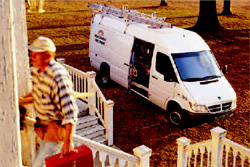Better electronic components and capabilities, which took off in the late 1980s and early ’90s and have continued to evolve, have improved most diesel engines. Electronics now control and monitor the entire engine system and internal computers track running conditions and allow operators and mechanics to perform engine diagnostics.
These electronic control and monitoring systems, along with more durable diesel engine components, have extended the life expectancy of trucks. “In the long run, engines are better today than they were 10 years ago: better materials and components, better transmissions, brake systems, and rear ends,” says Jim Zito, vocational sales manager for Peterbilt. Twenty years ago, a diesel truck would run between 100,000 and 200,000 miles in its lifetime. Now, Zito says, they can typically last up to 500,000 miles with proper maintenance and repairs.
Emissions Test All truck manufacturers have dedicated a significant amount of time and resources to improving new diesel engine emissions to comply with regulations from the Environmental Protection Agency (EPA), which has been regulating diesel engine emissions since 1974. An aggressive two-step plan implemented in 2004 set new emissions standards for heavy-duty diesel engines to reduce the release of nitrogen oxides and non-methane hydrocarbons by engines into the atmosphere from the previous 1998 standard. To meet the current standards,truck manufacturers have incorporated new technologies into their exhaust systems, including exhaust gas recirculation systems, oxidation catalysts, optimized combustion systems, and tur-bochargers.
The second stage of the emissions reduction plan, which will be phased in between 2007 and 2009, will implement even more stringent standards and mandate the use of diesel fuels with reduced sulfur levels.
As manufacturers worked toward meeting the 2004 emissions standards, they found that fuel economy was compromised by the emissions technologies, according to Kenworth Trucks’ Jeff Sass, market segment manager/on-highway product manager. Rob Swim, director of vehicle marketing for International Truck and Engine Corp.,explains that “The technology added to diesel engines for trucks has made engines more fuel efficient, but at the same time, the increased emissions standards have made the engines less efficient. The end result is that fuel economy has been relatively constant.”
Naturally, all this new technology has affected the price of trucks and will continue to do so, manufacturers say, though the price tag on most trucks has increased by only three to five thousand dollars in the past five to 10 years, they report.
On the Job Trends in the construction landscape itself also are driving advancements in trucking. As builders increasingly move in opposite directions—into the city and out to more rural suburbs—many dealers are building a more versatile and flexible fleet that can meet the needs of all their customers.
In markets where urban redevelopment and infill projects have become commonplace, delivery drivers face narrower roads, heavier traffic, and tighter lots and parking spaces, along with more potential for collisions with other vehicles, buildings, and pedestrians. While conventional-cab trucks are still prevalent throughout the industry, cab-over chassis—which position the engine directly beneath the cab and feature an extremely short front-bumper-to-back-of-cab dimension—are growing in popularity because their snub-nose design enables the driver to maneuver more easily in tight spaces. This design also better transfers weight to the front axle,and the flat front allows the driver to see about 2 feet directly in front of the truck—a distinct safety advantage.
At the same time, rural land development farther from urban centers is also booming, a scenario that forces dealers to deploy trucks for longer distances, thereby accumulating more miles, increasing wear and tear, and using more fuel. For lumberyards delivering in these areas, tractor trailers can be more advantageous because they can carry heavier materials and allow more materials to be delivered in one trip. One tractor can pull multiple trailers, as well.
In addition, one trailer-load of materials can be delivered to the jobsite, disconnected from the tractor, and left behind for unloading while the tractor goes back to the yard to pick up another loaded trailer. Tractor trailers, because of their design, also provide better maneuverability on jobsites than a straight truck.

